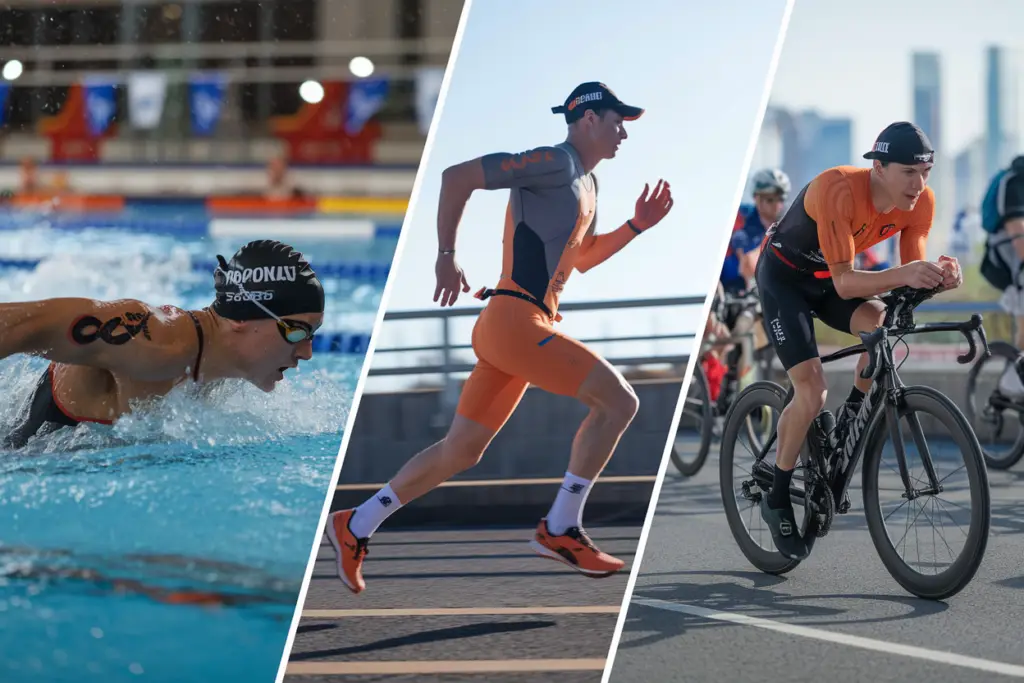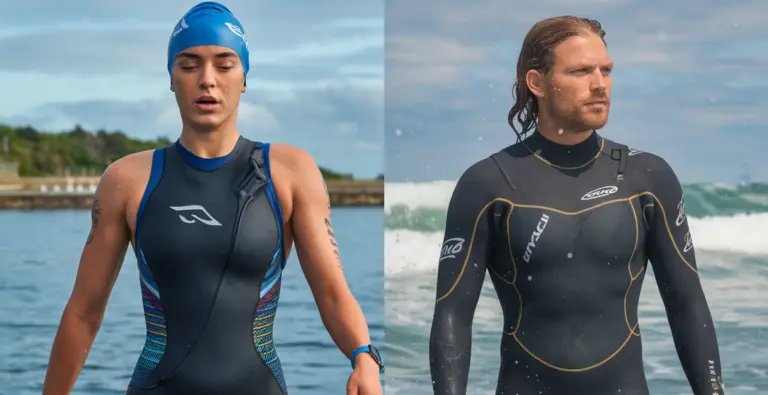Selecting the ideal wetsuit for aquatic pursuits can significantly elevate both your performance and overall comfort. But with so many options available, choosing between a triathlon wetsuit and a surfing wetsuit can be a perplexing decision. Both types are designed to enhance your aquatic experience, yet they cater to different needs and conditions. Whether you’re aiming for a speedy swim in an open-water triathlon or looking to ride the perfect wave, understanding the distinct advantages and limitations of each wetsuit type is crucial. In this guide, we’ll dive into the 12 key pros and cons of triathlon wetsuits versus surfing wetsuits, helping you make an informed choice for your next water adventure.
Triathlon Wetsuit vs. Surfing Wetsuit: What’s the Difference?
Both are crafted to enhance aquatic performance, but they’re designed with different priorities and environments in mind. Let’s break down the distinctive features and functionalities of each to help you decide which one suits your needs best.
Triathlon Wetsuits: Engineered for Speed and Efficiency
Triathlon wetsuits are meticulously designed to optimize your performance during competitive swimming. Here’s what sets them apart:
- Streamlined Buoyancy: These wetsuits are constructed with advanced buoyancy technologies that elevate your body position in the water, reducing drag and allowing for a more efficient stroke. This buoyancy is typically achieved through strategically placed foam panels.
- Flexible Neoprene: The high-stretch neoprene material used in triathlon wetsuits provides exceptional freedom of movement. This flexibility is crucial for maintaining a natural swimming motion, especially during long distances.
- Hydrodynamic Design: With a focus on hydrodynamics, triathlon wetsuits often feature a slick, low-friction outer layer. This design minimizes water resistance, ensuring you glide through the water with minimal effort.
- Quick-Release Zippers: Time is of the essence in triathlons, so these wetsuits come equipped with quick-release zippers for speedy transitions from swim to bike segments.
- Temperature Regulation: Triathlon wetsuits are engineered to provide warmth without overheating, thanks to their optimal thickness and thermal insulation properties.
Surfing Wetsuits: Built for Endurance and Protection
In contrast, surfing wetsuits are tailored to withstand the dynamic conditions of the ocean and offer different advantages:
- Durable Construction: Surfing wetsuits are built to endure the rough and abrasive nature of surfboards and ocean waves. They feature reinforced knee pads and robust stitching to enhance durability.
- Insulated for Cold Water: These wetsuits often come with thicker neoprene and additional thermal linings to keep surfers warm during extended sessions in cold water.
- Enhanced Flexibility: While also flexible, surfing wetsuits prioritize flexibility in specific areas like the shoulders and torso to facilitate paddling and movement on the board.
- Water Entry Prevention: Surfing wetsuits are designed with minimal water entry points, often incorporating features like smooth-skin cuffs and seals to keep water out and maintain core temperature.
- Agile Fit: The fit of a surfing wetsuit is more tailored to ensure that it remains snug against the body during active surfing, preventing water from flushing in and out.
- Weight: Insulation from cold water being the primary objective, the thickness is usually a bit higher and so it the weight of surfing wetsuits.

Detailed Comparison And Key Features
Choosing the right wetsuit involves comparing their features and understanding where you can purchase them. To simplify this, here’s a detailed comparison of triathlon wetsuits versus surfing wetsuits, followed by a guide on where to find these specialized gear.
Comparison Table: Triathlon Wetsuits vs. Surfing Wetsuits
| Feature | Triathlon Wetsuits | Surfing Wetsuits |
| Primary Purpose | Speed and efficiency in competitive swimming | Durability and warmth for extended ocean exposure |
| Buoyancy | High buoyancy with foam panels for improved body position | Moderate buoyancy with thicker neoprene for warmth |
| Flexibility | High flexibility for a natural swimming stroke | Enhanced flexibility in shoulders and torso for paddling |
| Material | Lightweight neoprene with hydrodynamic coating | Durable neoprene with additional insulation and padding |
| Zipper Type | Quick-release zippers for fast transitions | Back zippers or front zippers designed for ease of entry |
| Temperature Regulation | Balanced thermal insulation for varied water temperatures | Heavier insulation for colder water conditions |
| Durability | Moderate; designed for optimal performance rather than durability | High; built to withstand the abrasive nature of surfboards |
| Water Entry Prevention | Minimal water entry with streamlined design | Focus on preventing water ingress to maintain core warmth |
Where to Buy
Whether you’re gearing up for a triathlon or hitting the waves, finding the right wetsuit is crucial. Here’s a guide to where you can purchase both triathlon and surfing wetsuits:
- Specialized Sports Stores
- Triathlon Wetsuits: Stores like Triathlete Sports and Xterra Wetsuits offer a wide range of triathlon-specific wetsuits with expert guidance on fit and performance. They often provide the latest in wetsuit technology and brands renowned for competitive swimming.
- Surfing Wetsuits: Shops like Surfline and Body Glove specialize in surfing gear and offer an extensive selection of wetsuits designed to handle various surf conditions. They also feature high-quality brands known for their durability and insulation.
- Online Retailers
- Triathlon Wetsuits: Websites such as Amazon and Wetsuit Wearhouse have a comprehensive range of triathlon wetsuits, including customer reviews and detailed product descriptions. They often offer competitive pricing and the convenience of home delivery.
- Surfing Wetsuits: For surfing wetsuits, check out Reef and O’Neill’s online stores. These platforms provide detailed product specifications, customer reviews, and sometimes special discounts.
- Manufacturer’s Direct Stores
- Triathlon Wetsuits: Brands like Orca and 2XU have their own online stores where you can purchase directly from the manufacturer. This option often ensures you get the latest models and potentially exclusive deals.
- Surfing Wetsuits: For the latest innovations in surfing wetsuits, visit the official websites of brands like Rip Curl and Patagonia.
- Local Shops and Gear Exchanges
- Triathlon Wetsuits: Look for local triathlon clubs or gear exchanges where you can find high-quality second-hand wetsuits at a fraction of the cost. These are great for budget-conscious buyers.
- Surfing Wetsuits: Local surf shops often carry a variety of wetsuits and can provide personalized advice. Additionally, surf gear swaps and local forums can be useful for finding second-hand options.
Pros and Cons: Triathlon Wetsuits vs. Surfing Wetsuits
To help you decide which wetsuit best fits your needs, here’s a detailed breakdown of the 12 key pros and cons for both triathlon and surfing wetsuits.
Comparison Table
| Aspect | Triathlon Wetsuits | Surfing Wetsuits |
| 1. Buoyancy | Pro: Enhances body position for reduced drag and increased speed. | Pro: Provides sufficient buoyancy for warmth and comfort in cold water. |
| Con: Overly buoyant for some, may affect natural swimming stroke. | Con: Less buoyant compared to triathlon suits, potentially reducing speed. | |
| 2. Flexibility | Pro: High flexibility in the shoulders and torso for optimal swimming movement. | Pro: Excellent flexibility for paddling and maneuvering on the surfboard. |
| Con: Flexibility might be less in other areas compared to surfing suits. | Con: Could restrict some freedom of movement in competitive swimming. | |
| 3. Material | Pro: Lightweight and hydrodynamic, reducing water resistance. | Pro: Durable and abrasion-resistant, ideal for rough surf conditions. |
| Con: Less durable against rough surfaces or abrasions. | Con: Heavier material might affect speed and ease of movement. | |
| 4. Insulation | Pro: Balanced insulation to prevent overheating while maintaining warmth. | Pro: Extra insulation for prolonged warmth in cold water. |
| Con: May not provide enough warmth in extremely cold conditions. | Con: Over-insulation can lead to overheating during intense activity. | |
| 5. Zipper Design | Pro: Quick-release zippers for fast transitions. | Pro: Durable zippers designed to withstand the ocean environment. |
| Con: Quick-release features may be less robust over time. | Con: Some designs may be less convenient for quick changes. | |
| 6. Durability | Pro: High-performance design with advanced materials for competition use. | Pro: Built to withstand the harsh conditions of surfing, including abrasions. |
| Con: May wear out faster with regular use in rough environments. | Con: Durability features may add bulk and weight. | |
| 7. Water Entry Prevention | Pro: Streamlined design to minimize water entry and drag. | Pro: Effective water seals to keep warmth in and cold water out. |
| Con: Water may still enter through minor gaps during transitions. | Con: Water may slowly seep in over extended periods. | |
| 8. Comfort | Pro: Designed for a snug fit, enhancing overall swimming efficiency. | Pro: Comfortable fit for long surfing sessions, with additional padding. |
| Con: May feel restrictive during prolonged wear. | Con: Bulky design might be uncomfortable for some users. | |
| 9. Performance | Pro: Optimized for speed and efficiency in competitive swimming. | Pro: Enhances performance by providing warmth and flexibility for surfing. |
| Con: Not specifically designed for other water sports. | Con: May not offer the same level of performance for competitive swimming. | |
| 10. Transition Time | Pro: Designed to facilitate quick changes during multi-sport events. | Pro: Durable and easy to manage in surf conditions. |
| Con: Quick-release features can be prone to malfunction. | Con: Not optimized for fast transitions in multi-sport settings. | |
| 11. Fit | Pro: Sleek, form-fitting design reduces drag and enhances swim efficiency. | Pro: Customizable fit options to accommodate different body shapes and sizes. |
| Con: May require precise sizing for optimal performance. | Con: May feel loose or less streamlined compared to triathlon wetsuits. | |
| 12. Cost | Pro: Often less expensive than high-end surfing wetsuits. | Pro: Investment in durability and quality for long-term use. |
| Con: Higher-end models can be pricey. | Con: Typically more expensive due to additional features and durability. |

FAQs: Triathlon Wetsuits vs. Surfing Wetsuits
What is the main difference between a triathlon wetsuit and a surfing wetsuit?
Triathlon wetsuits are designed to enhance swimming performance by providing buoyancy, reducing drag, and improving speed. They feature high-stretch neoprene for flexibility and quick-release zippers for fast transitions. Surfing wetsuits, on the other hand, are built to withstand the harsh conditions of surfing. They focus on durability, warmth, and flexibility in key areas to help surfers stay comfortable and agile in the water.
Can I use a triathlon wetsuit for surfing?
While it’s technically possible, it’s not recommended. Triathlon wetsuits are optimized for swimming and may not offer the durability or warmth needed for surfing. They might wear out quickly when exposed to surfboards and rough conditions. Conversely, surfing wetsuits are built to handle these conditions and provide better protection and warmth for surfers.
How do I choose the right wetsuit size?
Choosing the correct size is crucial for performance and comfort. Wetsuits should fit snugly without restricting movement. Refer to the manufacturer’s size chart, which usually considers your height, weight, and chest measurements. Try on the wetsuit to ensure it fits well; there should be minimal water entry, and it should allow for unrestricted movement.
Are there specific features I should look for in a triathlon wetsuit?
Yes, key features include:
- High Buoyancy: Helps with body position and reduces drag.
- Flexible Neoprene: Allows for a natural swimming stroke.
- Quick-Release Zippers: Facilitates fast transitions.
- Hydrodynamic Design: Reduces water resistance.
What should I look for in a surfing wetsuit?
Key features for surfing wetsuits include:
- Durable Construction: Reinforced knee pads and strong stitching for longevity.
- Thermal Insulation: Thick neoprene and internal linings to keep you warm in cold water.
- Enhanced Flexibility: Freedom of movement, especially in the shoulders and arms.
- Water Entry Prevention: Smooth-skin cuffs and seals to minimize water ingress.
Can I wear a surfing wetsuit in a triathlon?
It’s not ideal. Surfing wetsuits are generally thicker and less flexible than triathlon wetsuits, which can hinder swimming efficiency and performance. They also lack the quick-release features needed for fast transitions.
How often should I replace my wetsuit?
The lifespan of a wetsuit depends on its usage and care. Typically, a wetsuit can last between 2 to 5 years. If you notice signs of wear such as leaks, thinning neoprene, or reduced flexibility, it might be time to replace it. Regular maintenance, like rinsing and proper storage, can extend its life.
What maintenance is required for wetsuits?
Proper care involves:
- Rinsing the wetsuit in fresh water after each use to remove salt and chlorine.
- Drying it inside out, away from direct sunlight and heat sources.
- Storing it on a wide hanger to maintain its shape.
- Avoiding harsh chemicals and rough surfaces that could damage the neoprene.
- Seam repair as soon as a crack appears to maitain insulation
Are there any alternatives to traditional wetsuits?
Yes, alternatives include wetsuit tops and drysuits. Wetsuit tops offer warmth for less extreme conditions, while drysuits provide superior insulation by keeping you completely dry, which is beneficial for colder waters.
How do I know if a wetsuit is good quality?
Good quality wetsuits usually feature:
- High-grade Neoprene: For flexibility and durability.
- Seam Construction: Sealed or taped seams for water resistance.
- Brand Reputation: Established brands known for their expertise in wetsuit manufacturing.
- Customer Reviews: Positive feedback from users can indicate reliability.
Conclusion
Choosing between a triathlon wetsuit and a surfing wetsuit hinges on understanding your primary activity and the specific features that cater to it. Triathlon wetsuits are engineered for speed and efficiency, with a focus on buoyancy, flexibility, and quick transitions. They are designed to minimize drag and help you glide through the water with ease, making them ideal for competitive swimming.
On the other hand, surfing wetsuits are built to endure the challenges of ocean surfing. They offer enhanced durability, insulation, and flexibility where it counts—especially in the shoulders and arms. Both types of wetsuits offer distinct advantages tailored to their intended use. By evaluating the specific features, such as buoyancy, flexibility, and durability, you can make an informed choice that enhances your performance and comfort. Whether you’re aiming for a personal best in your next triathlon or catching the perfect wave, selecting the right wetsuit will significantly impact your experience.
Ultimately, understanding the key differences and selecting a wetsuit that aligns with your activity and conditions will lead to better performance and enjoyment. Take the time to assess your needs, consider the tips and comparisons provided, and make a choice that best suits your water adventures.
For more interesting articles, read these:
Does Skateboarding Help Surfing? 10 Reasons Why
Is Surfing Exhausting? 10 Reasons Surfers Get Tired
Surfing vs Snowboarding: Which Is Harder?
Is Surfing Hard? 11 Reasons Why
Can You Surf Without Swimming Skills? 11 Essential Tips
The Ultimate Surf Travel Checklist: 15 Essential Accessories



